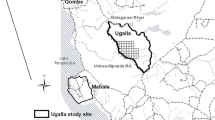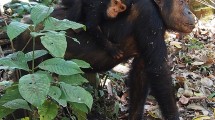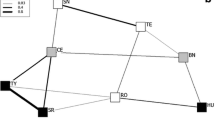Abstract
Female philopatry in mammals is generally associated with ecological and sometimes social benefits, and often with dispersal by males. Previous studies on dispersal patterns of orangutans, largely non-gregarious Asian great apes, have yielded conflicting results. Based on 7 years of observational data and mitochondrial and nuclear DNA analyses on fecal samples of 41 adult Bornean orangutans (Pongo pygmaeus wurmbii) from the Tuanan population, we provide both genetic and behavioral evidence for male dispersal and female philopatry. Although maternally related adult female dyads showed similar home-range overlap as unrelated dyads, females spent much more time in association with known maternal relatives than with other females. While in association, offspring of maternally related females frequently engaged in social play, whereas mothers actively prevented this during encounters with unrelated mothers, suggesting that unrelated females may pose a threat to infants. Having trustworthy neighbors may therefore be a social benefit of philopatry that may be common among solitary mammals, thus reinforcing female philopatric tendencies in such species. The results also illustrate the diversity in dispersal patterns found within the great-ape lineage.



Similar content being viewed by others
References
Anderson DJ (1982) The home range: a new nonparametric-estimation technique. Ecology 63:103–112
Archie EA, Moss CJ, Alberts SC (2006) The ties that bind: genetic relatedness predicts the fission and fusion of social groups in wild African elephants. Proc Roy Soc Lond B 273:513–522
Arora N, Nater A, van Schaik CP, Willems EP, van Noordwijk MA, Goossens B, Morf N, Bastian M, Knott C, Morrogh-Bernard H, Kuze N, Kanamori T, Pamungkas J, Perwitasari-Farajallah D, Verschoor E, Warren K, Krützen M (2010) Effects of Pleistocene glaciations and rivers on the population structure of Bornean orangutans (Pongo pygmaeus). Proc Natl Acad Sci USA 107:21376–21381
Bengtsson BO (1978) Avoiding inbreeding—at what cost? J Theor Biol 73:439–444
Bradley BJ, Doran-Sheehy DM, Vigilant L (2007) Potential for female kin associations in wild western gorillas despite female dispersal. Proc Roy Soc Lond B 274:2179–2185
Byers JA, Walker C (1995) Refining the motor training hypothesis for the evolution of play. Am Nat 146:25–40
Chapais B (2010) The deep structure of human society: primate origins and evolution. In: Kappeler PM, Silk JB (eds) Mind the gap. Tracing the origins of human universals, Springer Verlag, Berlin, pp 19–51
De Villiers PA, Kok OB (1997) Home range, association and related aspects of elephants in the eastern Transvaal Lowveld. Afr J Ecol 35:224–236
Di Fiore A, Link A, Schmitt CA, Spehar SN (2009) Dispersal patterns in sympatric woolly and spider monkeys: integrating molecular and observational data. Behaviour 146:437–470
Douadi MI, Gatti S, Levrero F, Duhamel G, Bermejo M, Vallet D, Menard N, Petit EJ (2007) Sex- biased dispersal in western gorilla (Gorilla gorilla gorilla). Mol Ecol 16:2247–2259. doi:10.1111/j.1365-294X.2007.03286.x
Eberle M, Kappeler PM (2006) Family insurance: kin selection and cooperative breeding in a solitary primate (Microcebus murinus). Behav Ecol Sociobiol 60:582–588
ESRI (2008) ArcGis 9.3. Environmental Systems Research Institute Inc, Redlands, CA
Fagen J (1981) Animal play behavior. Oxford University Press, New York
Fagen R, Fagen J (2009) Play behaviour and multi-year juvenile survival in free-ranging brown bears, Ursus arctos. Evol Ecol Res 11:1053–1067
Foley RA, Lee PC (1991) Ecology and energetics of encephalization in hominid evolution. Phil Trans Roy Soc B 334:223–232
Galdikas BMF (1985) Orangutan sociality at Tanjung Puting. Am J Primatol 9:101–119
Ghiglieri MP (1987) Sociobiology of the great apes and the hominid ancestor. J Hum Evol 16:319–357
Goodall J (1986) The chimpanzees of Gombe. Harvard University Press, Cambridge, MA
Goossens B, Setchell JM, James SS, Funk SM, Chikli L, Abulani A, Ancrenaz M, Lackman-Ancrenaz I, Bruford MW (2006) Philopatry and reproductive success in Bornean orangutans (Pongo pygmaeus). Mol Ecol 15:2577–2588
Graham KL, Burghardt GM (2010) Current perspectives on the biology study of play: signs of progress. Q Rev Biol 85:393–418
Greenwood PJ (1980) Mating systems, philopatry and dispersal in birds and mammals. Anim Behav 28:1140–1162
Hashimoto C, Takenaka O, Furuichi T (1996) Matrilineal kin relationship and social behavior of wild bonobos (Pan paniscus): sequencing the D-loop region of mitochondrial DNA. Primates 37:305–318
Hill KR, Walker RS, Božičević M, Eder J, Headland T, Hewlett B, Hurtado AM, Marlowe F, Wiessner P, Wood B (2011) Co-residence patterns in hunter-gatherer societies show unique human social structure. Science 311:1268–1289
Hoffman JI, Amos W (2005) Microsatellite genotyping errors: detection approaches, common sources and consequences for paternal exclusion. Mol Ecol 14:599–612
Holekamp KE, Smith JE, Strelioff CC, Van Horn RC, Watts HE (2012) Society, demography and genetic structure in the spotted hyena. Mol Ecol 21:613–632. doi:10.1111/j.1365-294X.2011.05240.x
Hrdy SB (2009) Mothers and others: the evolutionary origins of mutual understanding. Harvard University Press, Cambridge MA
Isbell LA, Van Vuren D (1996) Differential costs of locational and social dispersal and their consequences for female group-living primates. Behaviour 133:1–36
Jaeggi AV, Dunkel LP, van Noordwijk MA, Wich SA, Sura AAL, van Schaik CP (2010) Social learning of diet and foraging skills by wild immature Bornean orangutans: implication for culture. Am J Primatol 72:62–71
Kalinowski ST, Taper ML, Marshall TC (2007) Revising how the computer program CERVUS accommodates genotyping error increases success in paternity assignment. Mol Ecol 16:1099–1106
Kerth G, Safi K, König B (2002) Mean colony relatedness is a poor predictor of colony structure and female philopatry in the communally breeding Bechstein’s bat (Myotis bechsteinii). Behav Ecol Sociobiol 52:203–210
Kitchen AM, Gese EM, Waits LP, Karki SM, Schauster ER (2005) Genetic and spatial structure within a swift fox population. J Anim Ecol 74:1173–1181
Knott CD, Beaudrot L, Snaith T, White S, Tschauner H, Planasky G (2008) Female–female competition in Bornean orangutans. Int J Primatol 29:975–997
König B (2006) Non-offspring nursing in mammals: general implications from a case study on house mice. In: van Kappeler PM, Schaik CP (eds) Cooperation in primates and humans mechanisms and evolution. Springer, Berlin, pp 191–205
Krützen M, Barre LM, Connor RC, Mann J, Sherwin WB (2004) ‘O father: where art thou?’—Paternity assessment in an open fission–fusion society of wild bottlenose dolphins (Tursiops sp.) in Shark Bay, Western Australia. Mol Ecol 13:1975–1990
Langergraber K, Mitani J, Vigilant L (2009) Kinship and social bonds in female chimpanzees (Pan troglodytes). Am J Primatol 71:840–851
Langergraber KE, Mitani JC, Vigilant L (2007) The limited impact of kinship on cooperation in wild chimpanzees. Proc Natl Acad Sci USA 104:7786–7790
Lawson Handley LJ, Perrin N (2007) Advances in our understanding of mammalian sex-biased dispersal. Mol Ecol 16:1559–1578
Legendre P, Legendre L (1998) Numerical ecology, 2nd edn. Elsevier, Amsterdam
Lewis KP, Barton RA (2006) Amygdala size and hypothalamus size predict social play frequency in nonhuman primates: a comparative analysis using independent contrasts. J Comp Psychol 120:31–37
McEachern M, Eadie J, Van Vuren D (2007) Local genetic structure and relatedness in a solitary mammal, Neotoma fuscipes. Behav Ecol Sociobiol 61:1459–1469
Morrogh-Bernard HC, Morf N, Chivers DJ, Krützen M (2011) Dispersal patterns of orang-utans (Pongo spp.) in a Bornean peat-swamp forest. Int J Primatol 32:362–376
Moyer MA, McCown JW, Eason TH, Oli MK (2006) Does genetic relatedness influence space use pattern? A test on Florida black bears. J Mammal 87:255–261
Nater A, Nietlisbach P, Arora N, van Schaik CP, van Noordwijk MA, Willems EP, Singleton I, Wich SA, Goossens B, Warren KS, Verschoor EJ, Perwitasari-Farajallah D, Pamungkas J, Krützen M (2011) Sex-biased dispersal and volcanic activities shaped phylogeographic patterns of extant orangutans (genus: Pongo). Mol Biol Evol 28:2275–2288
Nietlisbach P (2009) Male specific markers in orangutans (Pongo spp.): dispersal and phylogeny. MSc Thesis, University of Zurich
Nunes S, Muecke E-M, Sanchez Z, Hoffmeier RR, Lancaster LT (2004) Play behavior and motor development in juvenile Belding’s ground squirrels (Spermophilus beldingi). Behav Ecol Sociobiol 56:97–105
Pellis SM (2010) Conservative motor systems, behavioral modulation and neural plasticity. Behav Brain Res 214:25–29
Pusey A, Williams J, Goodal J (1997) The influence of dominance rank on the reproductive success of female chimpanzees. Science 277:828–831
Pusey AE, Packer C (1987) Dispersal and philopatry. In: Smuts BB, Cheney DL, Seyfarth RM, Wrangham RW, Struhsaker TT (eds) Primate societies. Chicago University Press, Chicago, pp 250–266
Ratnayeke S, Tuskan GA, Pelton MR (2002) Genetic relatedness and female spatial organization in a solitary carnivore, the raccoon, Procyon lotor. Mol Ecol 11:1115–1124
Robbins A, Stoinski T, Fawcett K, Robbins M (2009) Socioecological influences on the dispersal of female mountain gorillas—evidence of a second folivore paradox. Behav Ecol Sociobiol 63:477–489
Rodgers AR, Carr AP, Beyer HL, Smith L, Kie JG (2007) HRT: Home Range Tools for ArcGIS, Centre for Northern Forest Ecosystem Research, Ont Min Nat Res, Thunder Bay, Ontario
Silk JB, Beehner JC, Bergman TJ, Crockford C, Engh AL, Moscovice LR, Wittig RM, Seyfarth RM, Cheney DL (2009) The benefits of social capital: close social bonds among female baboons enhance offspring survival. Proc R Soc Lond B 276:3099–3104
Silk JB, Beehner JC, Bergman TJ, Crockford C, Engh AL, Moscovice LR, Wittig RM, Seyfarth RM, Cheney DL (2010) Strong and consistent social bonds enhance the longevity of female baboons. Curr Biol 20:1359–1361
Singleton IS, Knott CD, Morrogh-Bernard HC, Wich SA, van Schaik CP (2009) Ranging behavior of orangutan females and social organization. In: Wich SA, Utami Atmoko SS, Setia TM, van Schaik CP (eds) Orangutans geographic variation in behavioral ecology and conservation. Oxford University Press, Oxford, pp 205–213
Singleton IS, van Schaik CP (2001) Orangutan home range size and its determinants in a Sumatran swamp forest. Int J Primatol 22:877–911
Singleton IS, van Schaik CP (2002) The social organisation of a population of Sumatran orangutans. Folia Primatol 73:1–20
Smith JLD (1993) The role of dispersal in structuring the Chitwan Tiger Population. Behaviour 124:165–195
Špinka M, Newberry RC, Bekoff M (2001) Mammalian play: training for the unexpected. Q Rev Biol 76:141–168
Støen O-G, Bellemain E, Sæbø S, Swenson J (2005) Kin-related spatial structure in brown bears Ursus arctos. Behav Ecol Sociobiol 59:191–197
Townsend SW, Slocombe KE, Emery Thompson M, Zuberbühler K (2007) Female-led infanticide in wild chimpanzees. Curr Biol 17:R355–R356
Utami Atmoko SS, Singleton IS, van Noordwijk MA, van Schaik CP, Setia TM (2009) Male–male relationships in orangutans. In: Wich SA, Utami Atmoko SS, Setia TM, van Schaik CP (eds) Orangutans geographic variation in behavioral ecology and conservation. Oxford University Press, Oxford, pp 225–234
Utami SS, Goossens B, Bruford MW, de Ruiter JR, van Hooff JARAM (2002) Male bimaturism and reproductive success in Sumatran orangutans. Behav Ecol 13:643–652
van Noordwijk MA, Sauren SEB, Nuzuar, Abulani A, Morrogh-Bernard HC, Utami Atmoko SS, van Schaik CP (2009) Development of independence Sumatran and Bornean orangutans compared. In: Wich SA, Utami Atmoko SS, Mitra Setia T, van Schaik CP (eds) Orangutans: geographic variation in behavioral ecology and conservation. Oxford University Press, Oxford, pp 189–203
van Schaik CP (1999) The socioecology of fission-fusion sociality in orangutans. Primates 40:73–90
van Schaik CP, van Hooff JARAM (1996) Towards an understanding of the orangutan’s social system. In: McGrew WC, Marchant LF, Nishida T (eds) Great ape societies. Cambridge University Press, Cambridge, pp 3–15
van Schaik CP, Wich SA, Utami SS, Odom K (2005) A simple alternative to line transects of nests for estimating orangutan densities. Primates 46:249–254
van Woerden JT, Pettersson J (2007) The effect of reproductive state on wild female orangutan ranging behavior (Pongo pygmaeus wurmbii). 2nd Congr Eur Fed Primatol, Prague, pp 71–72 (abstract).
Wakefield ML (2008) Grouping patterns and competition among female Pan troglodytes schweinfurthii at Ngogo, Kibale National Park, Uganda. Int J Primatol 29:907–927
Wartmann F, Purves R, van Schaik C (2010) Modelling ranging behaviour of female orang-utans: a case study in Tuanan, Central Kalimantan, Indonesia. Primates 51:119–130
Waser PM, Jones WT (1983) Natal philopatry among solitary mammals. Q Rev Biol 58:355–390
Watts P (1994) Social relationships of immigrant and resident female mountain gorillas, II: relatedness, residence, and relationships between females. Am J Primatol 32:13–30
Watts DP (2000) Causes and consequences of variation in male mountain gorilla life histories and group membership. In: Kappeler PM (ed) Primate males causes and consequences of variation in group composition. Cambridge University Press, Cambridge, pp 169–179
Wich SA, Utami-Atmoko SS, Mitra Setia T, Rijksen HD, Schürmann C, van Hooff JARAM, van Schaik CP (2004) Life history of wild Sumatran orangutans (Pongo abelii). J Hum Evol 47:385–398
Wild KD (2010) Female chimpanzees in Kanyawara community form social bonds and utilize valuable relationships despite female dispersal and male-bonded philopatry. Am J Phys Anthropol Suppl 50:243
Wolff JO, Peterson JA (1998) An offspring-defense hypothesis for territoriality in female mammals. Ethol Ecol Evol 10:227–239
Worton BJ (1989) Kernel methods for estimating the utilization distribution in home-range studies. Ecology 70:164–168
Acknowledgements
We are grateful to the Indonesian Institute of Science (LIPI), the Indonesian State Ministry for Research and Technology (RisTek), the Director General Departemen Kehutanan (PHKA), Departamen Dalam Negri, the local government in Central Kalimantan, the BKSDA Palangkaraya, the Bornean Orangutan Survival Foundation (BOSF) and MAWAS in Palangkaraya for their permission and support to conduct this research. We also thank the Fakultas Biologi Universitas Nasional (UNAS) in Jakarta for their collaboration and support for the Tuanan project and in particular drs. Tatang Mitra Setia and dr. Suci Utami Atmoko, and we gratefully acknowledge the collaboration of dr. Joko Pamungkas of PSSP-IPB with permit arrangements for the genetic samples. We are indebted to field team and in particular Pak Rahmatd and Pak Yandi for their help with collecting data and samples in the field. We thank Claude Rosselet and Pascal Marty for their work on the ArcGis database, and Alex Nater, Elvira Schneider and Moritz Fischer for their contributions to the genetic analyses. We thank the reviewers and David Watts for their constructive comments on the manuscript. Samples were exported from Indonesia to Switzerland under permits 07279/IV/SATS-LN/2009, 00961/IV/SATS-LN/2007 from the Convention on International Trade in Endangered Species of Wild Fauna and Flora. For major financial support we thank the University of Zurich, and the A.H. Schultz Stiftung.
Ethical standards
Behavioral observations comply with the Indonesian laws. The authors declare no conflict of interest.
Author information
Authors and Affiliations
Corresponding author
Additional information
Communicated by D. Watts
Rights and permissions
About this article
Cite this article
van Noordwijk, M.A., Arora, N., Willems, E.P. et al. Female philopatry and its social benefits among Bornean orangutans. Behav Ecol Sociobiol 66, 823–834 (2012). https://doi.org/10.1007/s00265-012-1330-7
Received:
Revised:
Accepted:
Published:
Issue Date:
DOI: https://doi.org/10.1007/s00265-012-1330-7




